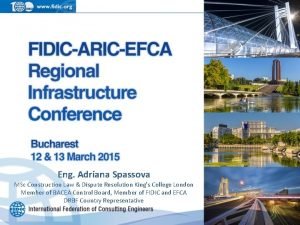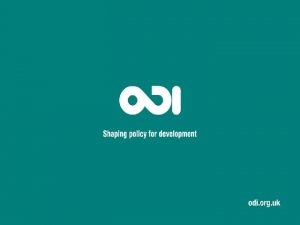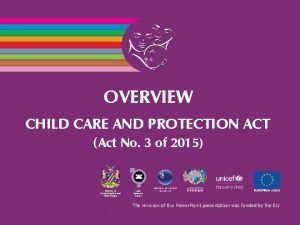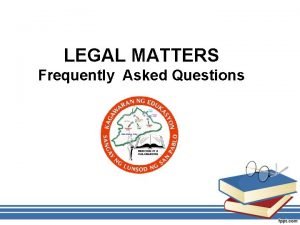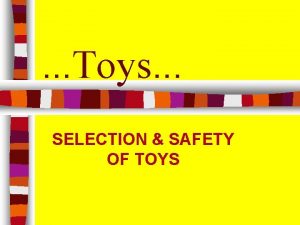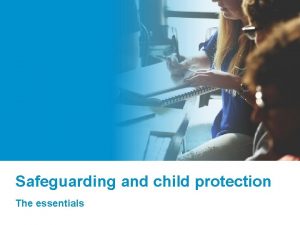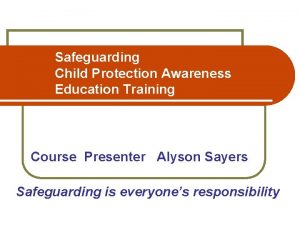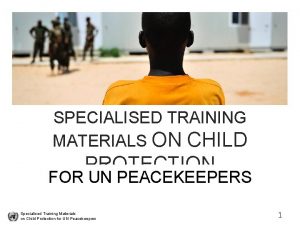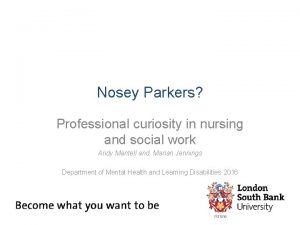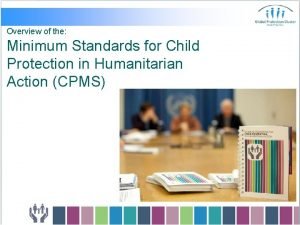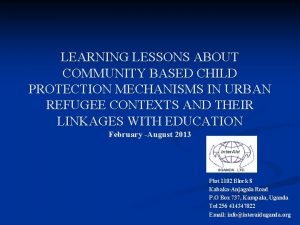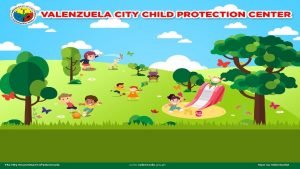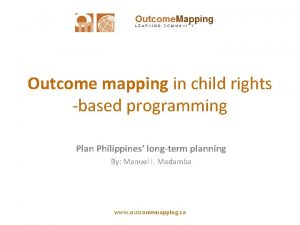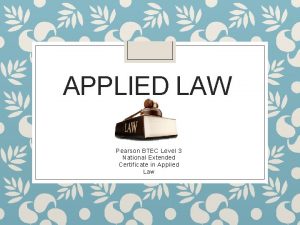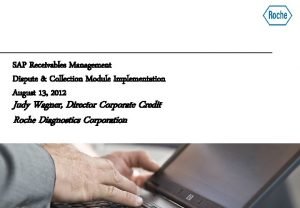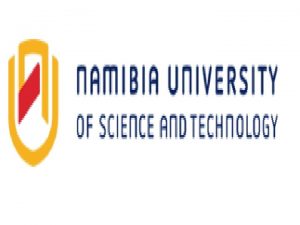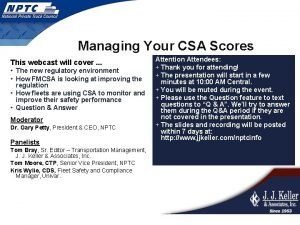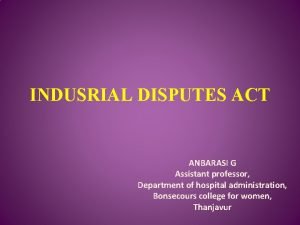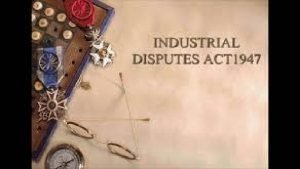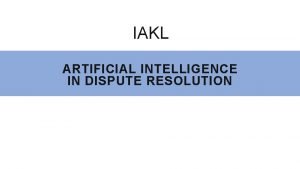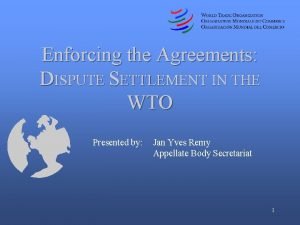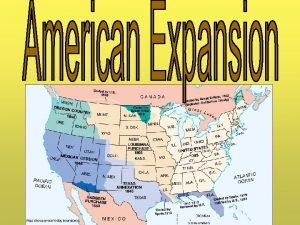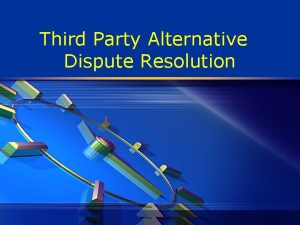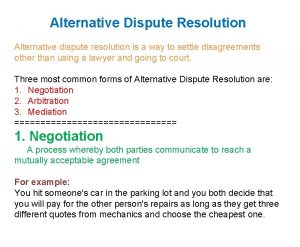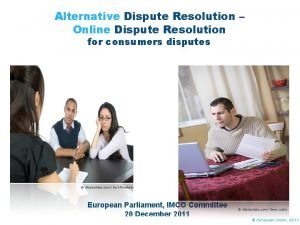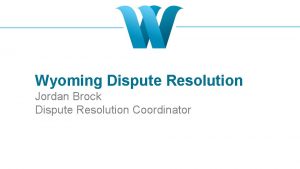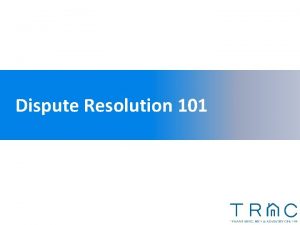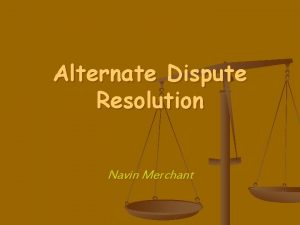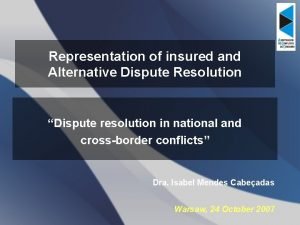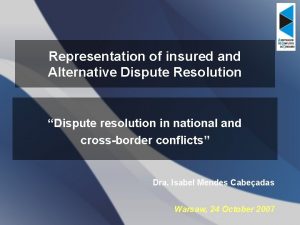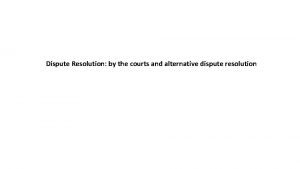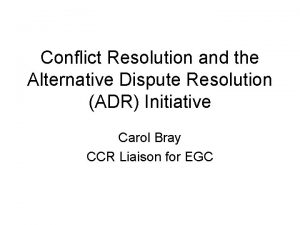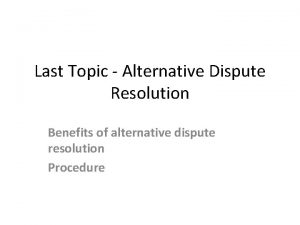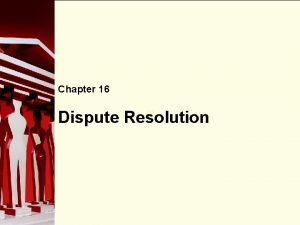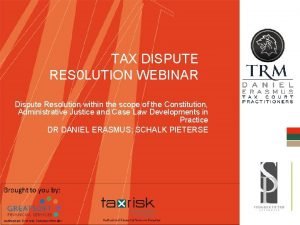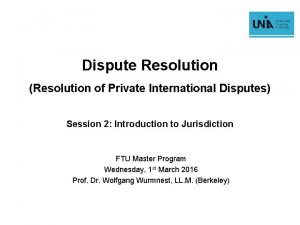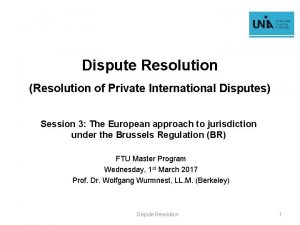Together 2016 Child Protection Alternative Dispute Resolution Symposium
































- Slides: 32

Together 2016 Child Protection Alternative Dispute Resolution Symposium Tuesday, November 15 th, 2016

Introductions Sylvia Pivko, MSW, RSW Executive Director – Blue Hills Child & Family Centre Amanda G. Lal, MSW, RSW Manager of Alternative Dispute Services and Community Development – Blue Hills Child & Family Centre Lisa Mc. Donald, BRE, BSW, MSW Aboriginal Approaches to ADR Facilitator/Consultant – Blue Hills Child & Family Centre & Dnaagdawenmag Binnoojiiyag Child & Family Services Amber Crowe, B. A. Hon. , J. D. Executive Director- Dnaagdawenmag Binnoojiiyag Child & Family Services Sally Rivers, MSW, RSW Director of Services - Dnaagdawenmag Binnoojiiyag Child & Family Services


Blue Hills Child & Family Centre Mission In the spirit of collaboration and respectful partnership with both families and the community, Blue Hills Child and Family Centre has, for over 47 years, been striving to create opportunities for children, youth and families to nurture their relationships and expand their abilities in realizing improved mental health.

Blue Hill’s ADR Community Partners Kawartha Family Court Assessment Service


History of DBCFS When this project began around 1998 the intent was to research, develop and implement a new model for the delivery of child & family services for our First Nations – a model that would result in more culturally based as well as more effective and efficient and consistent service delivery for our First Nations. In 2006, with the support of the Chiefs & Councils, DBCFS began the work necessary to move forward to define and develop our own Regional Child Welfare Body. DBCFS became incorporated in 2011.

Seven First Nation Communities S Alderville First Nation S Beausoleil First Nation S Curve Lake First Nation S Hiawatha First Nation S Georgina Island First Nation S Moose Deer Point First Nation S Scugog Island First Nation

Catchment Area Map

The Five CASs

DBCFS Programs S Child & Youth Mental Health & Addictions S Family Support Services S Native Youth & Justice Services S Youth in Transition

Regional Protocol The Protocol Concerning the Delivery of Child and Family Services is forged from distinct groups with differing worldviews and approaches developing a protocol that both respects the 7 First Nation communities and their respective 5 CASs and allows each to operate in unison to provide child welfare services.

Regional Protocol

History of Child Welfare ADR in Ontario S Bill 210 -CFSA - must consider ADR if child is or may be in need of protection S Policy Directive effective November 30, 2006 S CER-ADR model – effective Sept. 1, 2008

History of ADR in the former CER S Blue Hills was invited to host Central East Region ADR Service in 2006 S Blue Hills has taken a community development approach to the development of the CER ADR Service and has subsequently sub contracted the delivery of Child Protection Mediation and AA ADR in an urban setting

History of ADR in the former CER S Blue Hills took on the singular delivery of Family Group Decision Making across the CER as there was no organized service at the time S Quality Assurance and Model Integrity S Developed Leads and Steering Committee

History of ADR in the former CER S With regard to AA ADR, Blue Hills and the Ministry recognized that the path should and would be unique S We developed relationships with the 7 First Nation’s Prevention Workers who were already providing ODR (Original Dispute Resolution) in their communities S Together we shaped what AA ADR would look like on reserve S As DBCFS evolved towards mandate we partnered with them in our work with the First Nations that came under their umbrella S For urban families initially in Simcoe and then spreading across the CER, we worked closely with BANAC (Barrie Area Native Advisory Council) to understand support their model

History of ADR in the former CER S We quickly realized that the established role of the OCL needed to be reconsidered in AA ADR. The Band represents the child and only in rare circumstances does the OCL need to be involved. We collaborated with the OCL to explain and negotiate a differential approach by the OCL in AA ADR S Blue Hill’s approach has been and continues to be relational and supporting of community development and self-determination

The 4 ADR Approaches Other Durham Project – (Durham Only) Road 2 Resolution (York Only) Child Protection 04 Mediation Blue Hills DFCC and KFCAS Aboriginal Approaches/Original Dispute Resolution Urban – BANAC DBCFS Family Group Conferencing/Family Group Decision Making Blue Hills

Our Approach to AA ADR S It is an organic process that depends on the child, the family, the concern, the prevention worker/facilitator, the community and the CAS S Sometimes the ADRs are a series of small successes that build toward resolution S ADR is a very fluid process, sometimes with no definite start or finish time S The ADR can look quite different from one First Nation community to the next S Patience is required

Impacts of Colonization S The legacy of colonization, and particularly of residential schools and the Sixties Scoop, have had and continue to have a devastating effect on First Nations children, families, and communities, particularly with respect to their family structures, parenting, identities, and well being S CAS is a symbol of the difficulties Indigenous people face with respect to raising and parenting their children. It is also a system which has uprooted children, broken up families and stolen culture from future generations S There is currently more First Nation children in care than there was at the height of the residential schools S 60% of Indigenous children in the child welfare system had maltreatment substantiated due to neglect, compared to 30% of non-Aboriginal children

Overrepresentation of Young People in Residential Care S In 2013, 15. 5% of Crown Wards were Aboriginal S In Ontario, 3% of child population under age 15 is Aboriginal, and 21% of children in care First Nations children living offreserve 25% 20% Aboriginal Child Population 15% 10% Aboriginal Children in Care 5% 0% Aboriginal Children in Care

Overrepresentation of Young People in Residential Care 10% S In Ontario, First Nations children were 12 x more likely to be identified as foster children than non-Aboriginal S 3. 1% of First Nation children are in foster care compared to 0. 25% of non-Aboriginal S 9% of investigations involved Aboriginal children 8% Aboriginal Child Population 6% 4% Aboriginal Children Investigations 2% 0% Overrepresentation of Investigations

Colonization and ADR S Intergenerational trauma has occurred as a result of the residential schools and “Sixties Scoop” S The healing of families and caregivers takes time S Everyone’s journey on their healing path is different, and there can be no set time designated for healing S Aboriginal Approaches to ADR timeframes are measured differently than mainstream methods, and can take on many forms

Strategic Use of Community Capacity Building Grants S Grants initially used to build cultural capacity within 5 CASs S Developed relationships with First Nation communities and Child Welfare Agencies pertaining to AA ADR S Small-scale gatherings arranged to support Prevention Workers in referring, delivering and invoicing for AA ADR S Larger-scale gatherings focused on developing common understanding of AA ADR and how it might work in each community

Lessons Learned from TPA Perspective S Full inclusion of MCYS Program Supervisor in the development- build buy in S Working from a relational model and take building trust seriously S Be fully respectful- all the time S Do one’s homework- cultural awareness knowledge S Attend at each First Nations community, get to know Prevention Worker, other staff, Band Council members S Be as inclusive as absolutely possible- nothing about them without them

Lessons Learned from TPA Perspective S Honor all commitments made S Offer Consultation by trusted consultant to ODR deliverers S Strategic use of the Community Capacity Building Grant- have a shared vision S Partnership with DBCFS early on and then with the CCB grants S Always be aware of your mainstream power – never misuse it S Maintain a community development and system view and approach

Lessons Learned from TPA Perspective S Take the extra step, walk the extra mile S Never superimpose the mainstream model onto indigenous communities or families (decolonization) S Be flexible though in responding to families’ needs and request for traditional components or for none S Seek out advice from Elders S Educate the team (mainstream and Indigenous ADR) S Attend to turnover and offer orientation as often as needed

Lessons Learned from TPA Perspective S Never assert your way S Always be thoughtful about the impact of Colonization, Residential Schools, 60’s Scoop S Invest in Cultural awareness training for the 5 CAS’s S Support trying new things – e. g. ADR prior to CAS involvement S Advocate for the issues faced by First Nations communities

Lessons Learned from DBCFS S Definitions can be difficult S Trust in your allies’ genuineness S Be open and transparent about your intentions S Collaborate and “think out loud” S Be an “us” rather than an “us and them” with your partners; be true partners, it can work!

Lessons Learned from DBCFS S Be inclusive in planning S Expressions of frustration, anger, oppression are ok if done in a “good way” S Respect is a two way street S Be patient, decolonizing takes time on both sides (we are all colonized)

 Msc construction law
Msc construction law High resolution low resolution
High resolution low resolution Opvoedbelasting
Opvoedbelasting Types of child protection
Types of child protection Child care and protection act 3 of 2015
Child care and protection act 3 of 2015 Children's responsibilities
Children's responsibilities 2 disinterested person
2 disinterested person Child protection and toy safety act
Child protection and toy safety act Safeguarding and child protection the essentials
Safeguarding and child protection the essentials Child protection awareness training
Child protection awareness training Child protection training materials
Child protection training materials Child marriage definition
Child marriage definition Child protection reform amendment act 2017
Child protection reform amendment act 2017 Professional curiosity in child protection
Professional curiosity in child protection Courage child protection
Courage child protection Child protection minimum standards
Child protection minimum standards Child protection case management tools
Child protection case management tools Community based child protection mechanisms
Community based child protection mechanisms Opinyon tungkol sa child protection policy
Opinyon tungkol sa child protection policy Child protection committee in schools
Child protection committee in schools Unit 1 dispute solving in civil law
Unit 1 dispute solving in civil law Morphology definition ap human geography
Morphology definition ap human geography Krishna godavari dispute
Krishna godavari dispute Receivables management sap
Receivables management sap Rights dispute
Rights dispute Antecedent boundary example
Antecedent boundary example Csa basic thresholds
Csa basic thresholds Objectives of industrial dispute act 1947
Objectives of industrial dispute act 1947 Dispute management in order to cash
Dispute management in order to cash Objectives of industrial dispute act 1947
Objectives of industrial dispute act 1947 Dispute management ai
Dispute management ai Wto dispute settlement mechanism
Wto dispute settlement mechanism Maine vs canada war
Maine vs canada war
